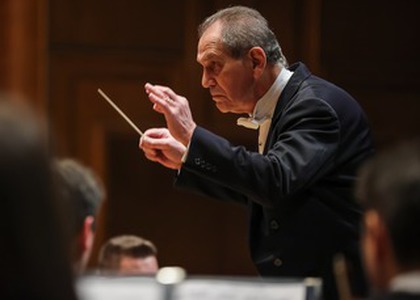> Interviews

Interview with conductor Cristian Mandeal
Cristian Mandeal returns to the Radio Chamber Orchestra on Wednesday evening, 24th of April 2024. On the programme, Francis Poulenc's Concerto in D minor for two pianos and orchestra and Gustav Mahler's Symphony No. 4, in an arrangement for chamber orchestra and soprano by Ronald Kornfeil.
How do you see the relationship between the two works in the concert programme?
Poulenc's Concerto for Two Pianos is one of the most successful pieces dedicated to this double piano ensemble, along with the Mozart concerto, the two Mendelssohn-Bartholdy concertos; it also has Dinu Lipatti for two pianos... But I find this Poulenc concerto one of the most attractive of the works written for these instruments. It is, of course, an event to have two pianists playing the same score, obviously multiplied to the possibilities of two pianos and not just one. The work is extremely varied, charming I would say, it has a lot of humour, a lot of wit, a lot of nostalgia, a lot of tenderness, a lot of grace and a lot of goodwill, if I may use the term, of the superior, aristocratic little expression of 20th century French music, neoclassical... of the neoclassical current of which Poulenc is a part.
Mahler - Symphony IV is, of course, a well-known work, but during the pandemonium and not only then, even before, even from the time of Arnold Schoenberg, it was used as the subject of a chamber orchestra. So, much simplified, much stylized, in the sense that this symphony allows a reduction of the massive orchestral instrument to a chamber ensemble. In this way, nothing is actually lost of the essence of the work, but it remains a different sound than the globalizing sound of a large orchestra. Here it is a sound specific to the chamber orchestra, a pen drawing rather than a thick brush, in which every detail is individualised in a wonderful polyphony, I would even say heterophony.
There is something in common between Mahler's language and Enescu's language, this heterophony, Mahler's for sure, which Enescu also used to the full in his creation... not knowing each other, not being able to speak here of direct influences, but simply of a rapprochement of two great spirits.
The fact is that Mahler's Fourth Symphony is, in a way, perhaps the most successful of Mahler's symphonies in that there is a certain identity, a certain unity of musical discourse, which is lacking in other symphonies. Incidentally, this would be one of the reasons why Celibidache, for example, has never conducted Mahler's works, as it seems to him that the works are architecturally less successful than the incomparable Anton Bruckner. So, this fourth by Mahler is extremely unified, as I said, and it is very much in the spirit of the fourth part of the first part, so there is a kind of bridge over time that is formed between the first and the last part.
However, it is the intimate, joyous, serene, chamber spirit that mainly dominates this symphony, except for the great Adagio in part three which, of course, has its dramatic, intense parts, typical of Mahler symphonic drama.
One could say that both works - and Poulenc's and Mahler's - have a childlike, simple quality.
Yes, I could call it naivety, if you like. Purity. Both are very pure music in the literal, and not just the literal, sense of the word.
Theodor Adorno said of Mahler's compositional practice that he turns cliché into event. How would you comment?
Yes, that seems to me a very good definition of Mahler's language. In fact, this is also the reason why Mahler was rejected for a number of years by traditional musicians, by this apparent lack of originality in the themes he used. Because Mahler's themes can often be counted as banal; they use musical prototypes that are much ironed out, much worn out in music. The originality of his melodies is quite rare, but out of this "banality" he really manages to create a whole world. He uses this simple, familiar material in an accessible way... maybe this is also the reason why he doesn't look for extremely original melodic things, but uses musical prototypes accessible to everyone, so that the result of these combinations is a deeply original music in the end, of an enormous density of information. Because that's what I think Mahler's strength is, the density of information per square centimetre.
Regarding the three soloists of the evening, pianists Oxana Corjos and Cristian Niculescu and the protagonist of the final part of the Mahlerian symphony, soprano Diana Țugui, how would you describe the collaboration?
With these two I have sung... this is the eighth time. We have performed five times, now it will be the sixth time, in Romania and twice in Germany, in Kasel and Berlin. Each time they have been very successful with the audience. They found each other, they fit together, they liked the concert, they learned it especially when I suggested that we play it together and it was repeated on several occasions. So I hope, for Wednesday evening too, that we will enjoy a real musical and solo event. As for Diana Țugui, I know her from various collaborations in vocal-symphonic music in which she often sang the soprano part with me in various works. I also remember Brahms' Recviem, I remember Beethoven's Ninth Symphony, and I especially remember Beethoven's Missa solemnis, in which she sang the enormously demanding part of the vocal quartet as soprano.
Translated by Vlad-Cristian Dinu,
University of Bucharest, Faculty of Foreign Languages and Literatures, MTTLC, year I
Corrected by Silvia Petrescu














